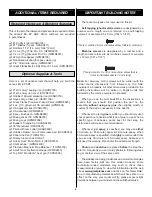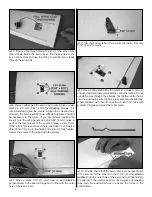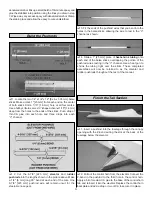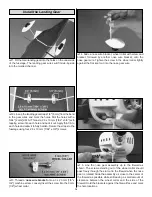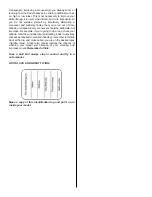
❏
6. Align the horizontal stabilizer onto the fuselage by
measuring the distances between the trailing edge wing tips
and making them equal on both sides. Also, center the
stabilizer left and right onto the fuselage and be sure the
stab is positioned as far forward as it will go. Stand back
several feet and look at the model from behind. Confirm that
the wing and stab are parallel. Adjust the area where the
stab sits on the fuse as necessary until they are parallel. The
elevator control horn will fit into the slot at the aft end of the
fuselage. A clamp is extremely useful in this step to hold the
position of the stab onto the fuse.
❏
7. Trace around the fuselage onto the underside of the
stabilizer with a felt-tip or panel line pen.
❏
8. Remove the stabilizer from the fuselage. Cut away the
covering just inside your lines on the underside of the
fuselage. If you use a hobby knife to cut the covering, be
careful not to cut the balsa wood underneath which could
result in compromising the strength of the stabilizer.
❏
9. Roughen up the portion of the fuselage with sandpaper
where the stabilizer will be installed. Clean the area with
Use a straightedge to guide the soldering iron at a rate
that will just melt the covering and not burn into the wood.
The hotter the soldering iron, the faster it must travel to
melt a fine cut. Peel off the covering.Use a straightedge to
guide the soldering iron at a rate that will just melt the
covering and not burn into the wood. The hotter the
soldering iron, the faster it must travel to melt a fine cut.
Peel off the covering.
Use a soldering iron to cut the covering from the stab. The
tip of the soldering iron doesn’t have to be sharp, but a
fine tip does work best. Allow the iron to heat fully.
HOW TO CUT COVERING FROM BALSA
10




